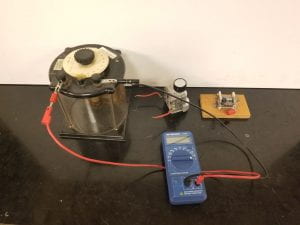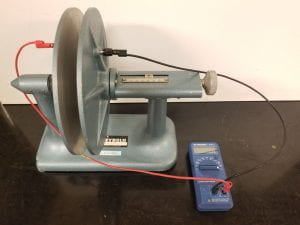Demonstration showing capacitors with variable capacitance, achieved through rotating overlapping metal plates.
Equipment:
- Rotating variable capacitors [Cabinet F1]
- Large sliding parallel plate capacitor [Cabinet F3]
- Capacitance meter (BK Precision) [Below cabinet J]
- Banana jacks and alligator clips
- Flat head screwdriver
- Video camera
Demo:
Begin by setting up the video camera to project an image of the capacitance meter for students to view. Then attach banana jacks and or alligator clips to one of the variable capacitors. Next, connect the other end of the banana jacks to the capacitance meter. Turn on the meter by rotating it’s large dial to a scale of somewhere between 200 pF and 200 nF. The ideal setting will depend on which capacitor is being used, but this scale can be easily adjusted during capacitor use. With the meter hooked up, begin adjusting the capacitance. This process varies between all capacitors, but in general will involve some form of rotation or translation. Figure 1 shows the rotating capacitors provided, who’s capacitance is adjusted by rotating a knob or turning the flat head screw. Figure 2 shows the translational capacitor, who’s capacitance is changed by sliding the right-hand plate towards or away from the left plate.
Written by Noah Peake

